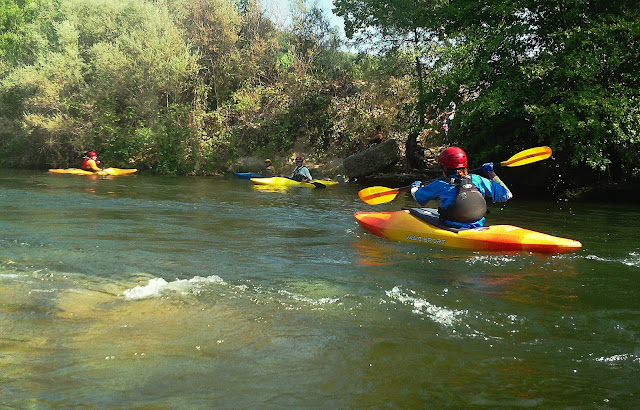- Wallace Stegner
"Swimming is part of the sport." said whitewater paddling instructor Dennis Eagan, "Every paddler, even the good ones are in between swims."
That was a shot of reassurance for the class, that everyone starts out the same, paddling skills are learned and developed over time and being able to swim in fast water is always an essential part of whitewater kayaking no matter what your levels of abilities. It's the basis for Whitewater River Kayaking 1 (RK1) with Current Adventures Kayak School and Trips. A class to develop a foundation and skills necessary to paddle fast water. In talking with the class participants, I learned most had some experience with fast water and one had even rafted down the Grand Canyon. However, the reason they were there was to learn the fundamentals by getting back to the basics of paddling.
"I want to do the Grand Canyon next year, " said student Scott Billups, "I've done quite a bit of sea kayaking in Alaska and have a SOT on my sailboat which I use quite a bit for diving and coastal touring. I've always thought that it (whitewater kayaking) would be fun but never lived close enough to whitewater to make it worthwhile. Sea kayaks want to run straight and cover a lot of ground as effortlessly as possible. Whitewater kayaks just want to turn and play."
It was a typical summer weekend on the South Fork of the American River atHenningsen-Lotus Park in Northern California.
Flows and the river traffic were high. It seemed like an endless parade of river rafts, kayaks and tubers floating down the stream while we unloaded and fitted the class up with their kayaks. "The fit it really important," Eagan told the students, "You want to be snug and your boat. That is really important. It gives you more control. You want to be snug like the boat is a part of you. Snug but comfortable.
After sliding into their kayaks and into the river, one by one, the students are literally submerged into the world of kayaking with wet exits and bow rescues.
In the bow rescue, Eagan capsizes each student as they hold the bow of another student's boat forming a T and progressively tips the kayak further and further over until they can complete a roll from upside down. Two different skills are practiced by the students, Staying in your kayak while using the support of another kayak to bring you upright and learning stability for the rescuer. Also, the students, get a boost of confidence in overcoming any fears of being upside down underwater. "No issues really." said Billups, "I do a lot of diving and am very comfortable in the water."
The South Fork is known for its dependable flows of whitewater. Popular rapids like Barking Dog, Troublemaker and Meatgrinder are just some of the rough waters that make the river attractive to the area kayakers. However, on the first day of the class, Eagan started with an easy moving section of the river to introduce some basic paddling strokes and techniques. "Most people do not spend enough time on flat water when they are learning to kayak." Eagan told the class, "I see lots of kayakers paddling down the gorge in Class III whitewater, but they still haven't developed a really good stroke technique. And even though they are paddling Class III they still haven't got that good foundation, because everyone is in the rush to get into the excitement of the white water instead of working on the drills."
For the rest of the session, the paddling students practiced integrating and completing their strokes and edging ability while working on an assortment of river maneuvers. "Once you get edging down you won't tip over very much," Eagan told the boaters. Edge control is a skill used for balance and control of the kayak. It involves holding the kayak tilted on one side (edge) or moving it from side to side (edge to edge) in the oncoming current, while at the same time as performing bracing strokes. "In any paddling, there are only three problems that you have." said Eagan, "One is momentum. You don't have enough speed. Two, You don't enough edging, and the other is boat angle. The last your going to working for the rest of your (paddling) career."
With increased confidence later on that afternoon, the paddling students were weaving and gliding through rocks and ripples along the South Fork while practicing ferrying, a maneuver to get across the river, along with eddy turns and peel outs. It was a day getting back to basics and learning some new skills over again. "It's not thinking about any text-book stroke, " said Eagan, "But, blending them all together."
Whitewater kayaking is an ongoing journey. As the poet Herman Hesse said "The river has taught me to listen; you will learn from it, too. The river knows everything; one can learn everything from it." It's consequential that kayakers keep listening, learning, and holding true to their paddling basics.
If you want to go
Current Adventures Kayak School and Trips PHONE: 530-333-9115 or Toll-Free: 888-452-9254
FAX: 530-333-1291
USPS: Current Adventures, P.O. Box 828, Lotus, CA 95651
info@currentadventures.com
owner Dan Crandall dan@kayaking.com
This article was originally published in Outside Adventure to the Max October 10, 2015.







No comments:
Post a Comment